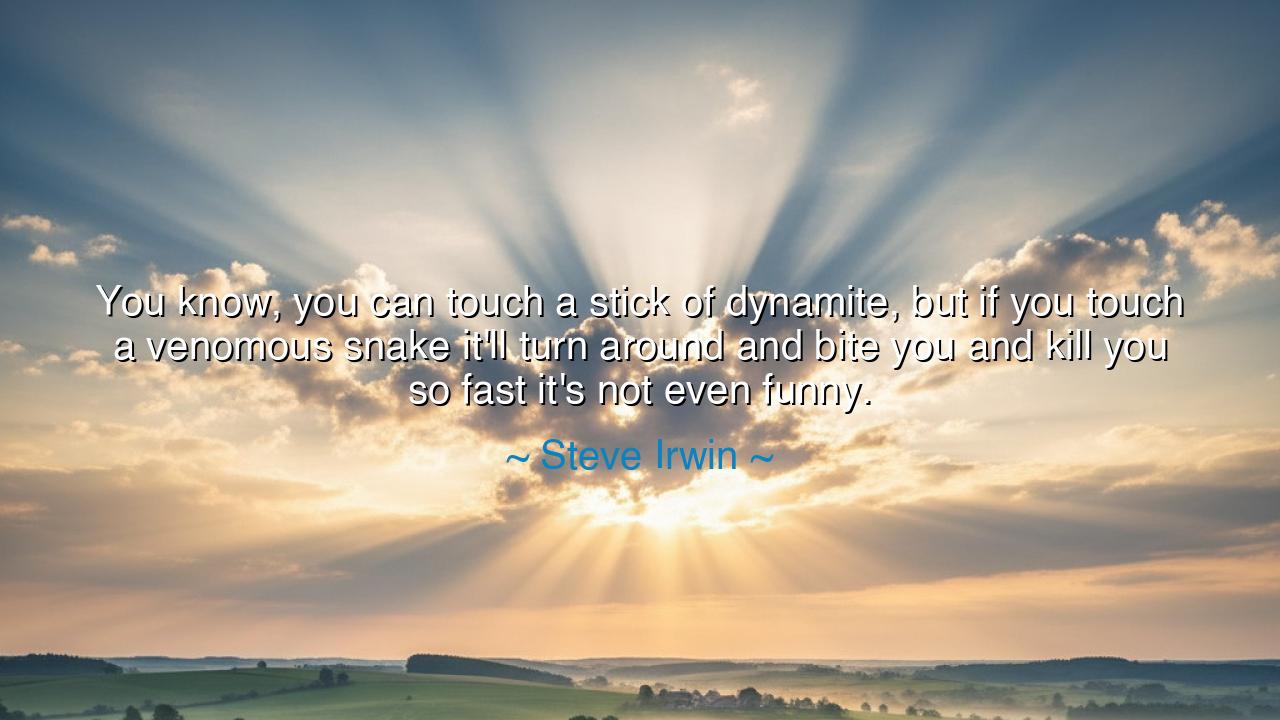
You know, you can touch a stick of dynamite, but if you touch a
You know, you can touch a stick of dynamite, but if you touch a venomous snake it'll turn around and bite you and kill you so fast it's not even funny.






In the words of Steve Irwin, “You know, you can touch a stick of dynamite, but if you touch a venomous snake it’ll turn around and bite you and kill you so fast it’s not even funny.” — there lies not only the wisdom of a man who lived among the fiercest creatures of the earth, but also a timeless parable about respect, instinct, and the nature of danger. Irwin, the beloved Crocodile Hunter, speaks here with his usual passion and plain-spoken clarity, yet beneath the surface of his words flows an ancient truth: that the most dangerous things in life are not always those that seem the most explosive, but those that are alive, unpredictable, and provoked without understanding.
The meaning of this quote reaches far beyond the world of wildlife. When Irwin speaks of dynamite and venomous snakes, he is not only talking about the difference between man-made and natural danger, but about the power of life itself. Dynamite, though deadly, is inert until ignited; it waits, still and silent, under the hand of human will. But the snake — that ancient symbol of nature’s cunning and balance — is its own master. It needs no spark to strike. Its defense is born of instinct, its vengeance of fear. And so Irwin’s warning is not only about the creatures of the field, but about the forces in life that must not be trifled with, the living energies that react not from logic, but from the deep pulse of survival.
In his words, one can hear the echo of the ancients who spoke of the serpent as both sacred and perilous. In the stories of Eden, the snake was the bearer of forbidden knowledge — a creature whose wisdom was as deadly as its bite. To touch such a being carelessly was to invite destruction, not because it was evil, but because it demanded respect. So too does Irwin teach that danger is not always malicious; it is simply the law of nature defending itself. Those who approach without understanding — who mistake curiosity for control — will find that life’s most beautiful creations can also be its most unforgiving.
This lesson was written, not in myth, but in the life of Steve Irwin himself. He lived in harmony with creatures that most men feared — crocodiles, snakes, and sharks — not because he lacked caution, but because he possessed reverence. He understood that to survive among such beings, one must first surrender arrogance. He often said that animals were not out to harm people; they struck only when threatened. Thus, the true danger lies not in the creature, but in the human hand that reaches without respect. His quote, simple yet profound, carries this eternal teaching: that wisdom begins with humility before the forces of nature and life.
The origin of this insight comes from Irwin’s decades spent face-to-face with the raw laws of the natural world. Unlike the artificial perils humans create — weapons, machines, explosives — nature’s power is pure, unmechanical, and alive. The venomous snake, coiled and alert, is not evil but precise. It strikes not from rage, but from instinct — a reminder that not all dangers announce themselves with noise or threat. Some are silent, watching, waiting for respect that is too often denied. In this, Irwin reminds us that true danger lies not in power alone, but in the misunderstanding of power.
The lesson here, my friends, is not one of fear, but of wisdom. Respect the living forces around you — in nature, in people, and within yourself. There are hearts and minds, like venomous snakes, that strike when provoked, not out of evil but from wounded defense. There are emotions, like dynamite, that seem inert but can be safely handled until sparked by recklessness. Learn to recognize the difference. Approach life not with domination, but with reverence. The wise person does not test every danger; they observe, they listen, and they act with understanding.
Therefore, let us live as Steve Irwin lived — with courage tempered by care, with enthusiasm bound to empathy. Let us not confuse boldness with recklessness, nor curiosity with wisdom. For the world, like the wild, is full of living forces that demand respect. When we touch them carelessly, we invite destruction; but when we honor them rightly, they reveal their beauty. The snake that can kill with one strike is also the guardian of balance, the keeper of the earth’s oldest mysteries.
And so, remember this: the greatest wisdom lies not in taming what is dangerous, but in learning to live beside it. Whether in the jungles of nature or the labyrinths of the heart, respect the things that can wound you — for they are often the same things that can teach you. Approach life’s venom not with arrogance, but with awe, and you will find that even the fiercest forces will show you their grace.






AAdministratorAdministrator
Welcome, honored guests. Please leave a comment, we will respond soon